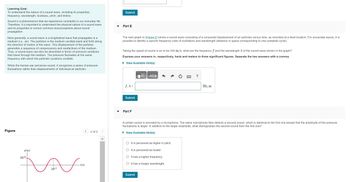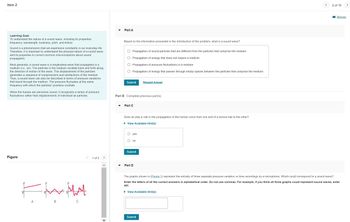
College Physics
11th Edition
ISBN: 9781305952300
Author: Raymond A. Serway, Chris Vuille
Publisher: Cengage Learning
expand_more
expand_more
format_list_bulleted
Concept explainers
Question
thumb_up100%

Transcribed Image Text:Learning Goal:
To understand the nature of a sound wave, including its properties:
frequency, wavelength, loudness, pitch, and timbre.
Sound is a phenomenon that we experience constantly in our everyday life.
Therefore, it is important to understand the physical nature of a sound wave
and its properties to correct common misconceptions about sound
propagation.
Most generally, a sound wave is a longitudinal wave that propagates in a
medium (i.e., air). The particles in the medium oscillate back and forth along
the direction of motion of the wave. This displacement of the particles
generates a sequence of compressions and rarefactions of the medium.
Thus, a sound wave can also be described in terms of pressure variations
that travel through the medium. The pressure fluctuates at the same
frequency with which the particles' positions oscillate.
When the human ear perceives sound, it recognizes a series of pressure
fluctuations rather than displacements of individual air particles.
Figure
x(m)
10-8
V
10-3
t(s)
2 of 2
Submit
Part E
The next graph in (Figure 2) shows a sound wave consisting of a sinusoidal displacement of air particles versus time, as recorded at a fixed location. For sinusoidal waves, it is
possible to identify a specific frequency (rate of oscillation) and wavelength (distance in space corresponding to one complete cycle).
Taking the speed of sound in air to be 344 m/s, what are the frequency f and the wavelength of the sound wave shown in the graph?
Express your answers in, respectively, hertz and meters to three significant figures. Separate the two answers with a comma.
► View Available Hint(s)
17| ΑΣΦ
f₁ λ =
Submit
Part F
It is perceived as higher in pitch.
It is perceived as louder.
It has a higher frequency.
It has a longer wavelength.
?
A certain sound is recorded by a microphone. The same microphone then detects a second sound, which is identical to the first one except that the amplitude of the pressure
fluctuations is larger. In addition to the larger amplitude, what distinguishes the second sound from the first one?
► View Available Hint(s)
Submit
Hz, m

Transcribed Image Text:Item 2
Learning Goal:
To understand the nature of a sound wave, including its properties:
frequency, wavelength, loudness, pitch, and timbre.
Sound is a phenomenon that we experience constantly in our everyday life.
Therefore, it is important to understand the physical nature of a sound wave
and its properties to correct common misconceptions about sound
propagation.
Most generally, a sound wave is a longitudinal wave that propagates in a
medium (i.e., air). The particles in the medium oscillate back and forth along
the direction of motion of the wave. This displacement of the particles
generates a sequence of compressions and rarefactions of the medium.
Thus, a sound wave can also be described in terms of pressure variations
that travel through the medium. The pressure fluctuates at the same
frequency with which the particles' positions oscillate.
When the human ear perceives sound, it recognizes a series of pressure
fluctuations rather than displacements of individual air particles.
Figure
FWM
0
A
با عمل سام
B
<
C
1 of 2 >
Part A
Based on the information presented in the introduction of this problem, what is a sound wave?
O Propagation of sound particles that are different from the particles that comprise the medium
Propagation of energy that does not require a medium
Propagation of pressure fluctuations in a medium
O Propagation of energy that passes through empty spaces between the particles that comprise the medium
Submit
Part B Complete previous part(s)
Part C
Does air play a role in the propagation of the human voice from one end of a lecture hall to the other?
► View Available Hint(s)
yes
no
Submit
Request Answer
Part D
Submit
2 of 15
Review
The graphs shown in (Figure 1) represent the entirety of three separate pressure variation vs time recordings by a microphone. Which could correspond to a sound wave?
Enter the letters of all the correct answers in alphabetical order. Do not use commas. For example, if you think all three graphs could represent sound waves, enter
ABC.
► View Available Hint(s)
Expert Solution
arrow_forward
Step 1
A) To explain the sound wave.
C) To explain the propagation of human voice in the air.
D) To check which pressure vs time graph tells the propagation of sound from the given graph.
E) Given that,
The speed of sound is
The graph is

To find frequency and the wavelength of the sound.
Trending nowThis is a popular solution!
Step by stepSolved in 6 steps with 3 images

Knowledge Booster
Learn more about
Need a deep-dive on the concept behind this application? Look no further. Learn more about this topic, physics and related others by exploring similar questions and additional content below.Similar questions
- Why does ambulance sounds low pitched when it passes by? A. Wavelength contracts so frequency decreases B. Wavelength decreases do amplitude increases C. Wavelength decreases so amplitude decreases D. Wavelength expands so frequency gets lowerarrow_forwardQuestion 5 Saved A wave travelling to the left is described by the equation y = 3 sin(5t + 2x) The wave collides with a solid barrier and reflects back, being described by the equation y=-3sin(5t-2x). What is the equation of the standing wave produced? Oy=3sin(5t)cos(2x) y=3sin(2x)cos(5t) y = 6sin(2x)cos(5t) y = 6sin(5t)cos(2x)arrow_forwardQuestion . Listen You turn up your radio and measure a volume level increase of 30 dB. This means that the intensity of the sound increases times. A) 1000 B) 10 C) 100 D) 30 Question 2, Listen A driver of car moving at 50 km/h presses its horn. A bystander moving at 10 km/h hears a higher frequency than the horn actually makes. Which of the following MUST be true? A) The bystander must be moving towards the car. B) The car must be moving towards the bystander. C) The car and bystander must both be moving towards each other. D) None of the above. Question 3 Listen The lowest tone to resonate in an open pipe of length Lis 200 Hz. Which one of the following frequencies will not resonate in the same pipe? O A) 400 Hz B) 600 Hz C) 800 Hz D) 500 Hzarrow_forward
- K 2. Resonances in a Tube A student is given a tube of unknown length and cannot tell whether the ends of the tube are open or closed. Given a tunable sound generator the student measures the frequencies of the two lowest resonances in the tube to be 235 Hz and 587 Hz. a. Explain why this student must be mistaken in the measurement. b. Is it possible that the student measured the lowest frequency correctly and simply missed some resonances between the two given above? If so, what would those missed frequencies be and what conclusion about end conditions can you reach? If not, why not?arrow_forwardQUESTION 2 Which of the following media cannot support a transverse wave? a. The atmosphere b. A steel bar O c. An aluminum rod d. The crust of the earth e. A lakearrow_forwardstanding wavearrow_forward
- q18arrow_forwardYou try to form standing waves in an air column by using a tuning fork. How would you know that you hit a resonance at a certain length? Select all the correct answers. Select one or more: a. The sound frequency would decrease b. The sound would get quieter c. The sound would get louder d. The sound frequency would increasearrow_forwardPart 1: Trains with passengers A railroad train is traveling at 34.2 m/s in still air. The frequency of the note emitted by the train whistle is 220 Hz. The air temperature is -9°C. A.) What frequency is heard by a passenger on a train moving in the opposite direction to the first at 35.8 m/s and approaching the first? B.) What frequency is heard by a passenger on a train moving in the opposite direction to the first at 35.8 m/s and receding from the first?arrow_forward
- Group Problem Chapter 18 Two sinusoidal waves in a string are defined by the wave functions with x and y in cm (so k is in rad/cm) and t in s. yı(x,t) = 2.10 sin (18.0x – 31.0t) y2(x,t) = 2.10 sin (30.0x – 45.0t) a) What is the phase difference between these two waves at the point x1=5.00cm and tj=2.00s? (Pick an angle between 0° and 360°.) b) What is the positive x value closest to the origin for which the two arguments differ by +(2n+1)n at t1? At that location the two waves destructively interfere. (Hint: it's not the n=0 case!)arrow_forwardSuperposition and Standing Waves A standing wave occurs when two travelling waves with the same wavelength and wave speed pass through each other in opposite directions. Mathematically the first wave is written as: Y, (x, t) = A cos(kx – wt) and the second wave: Y,(x, t) = A cos(kx + wt) where the wave number, k = 2/2, the natural frequency w = 27/r, and A and T are the wavelength and period of the waves, respectively. The positive and negative signs of w show that the waves are travelling in opposite directions. Demonstrate that the sum of these two waves, Ysum = Y1 + Y2, results in a sinusoidal wave, Y(x) with a wavelength A and an amplitude that is twice that of each wave individually. Furthermore, as time advances, the amplitude is oscillating between +A and -A with a period, T. Repeat the summation, only now assume the other harmonic wave form: Y, (x, t) = A sin(kx – wt) and the second wave: Y2(x, t) = A sin(kx + wt) The following trigonometric identities may be helpful: sin(a +…arrow_forwardment PRINTER VERSION 1 BACK NEXT Chapter 16, Problem 024 GO A wave traveling along the x axis is described mathematically by the equation y = 0.17sin(2.3nt + 0.68nx), where y is the displacement (in meters), t is in seconds, and x is in meters. What is the speed of the wave? %3D Number Units the tolerance is +/-5% GO TUTORIAL LINK TO TEXT By accessing this Question Assistance, you will learn while you earn points based on the Point Potential Policy set by your instructor. Question Attempts: 0 of 6 used SAVE FOR LATER SUBMIT ANSWER MacBook Pro Q Search or tyne URIarrow_forward
arrow_back_ios
SEE MORE QUESTIONS
arrow_forward_ios
Recommended textbooks for you
 College PhysicsPhysicsISBN:9781305952300Author:Raymond A. Serway, Chris VuillePublisher:Cengage Learning
College PhysicsPhysicsISBN:9781305952300Author:Raymond A. Serway, Chris VuillePublisher:Cengage Learning University Physics (14th Edition)PhysicsISBN:9780133969290Author:Hugh D. Young, Roger A. FreedmanPublisher:PEARSON
University Physics (14th Edition)PhysicsISBN:9780133969290Author:Hugh D. Young, Roger A. FreedmanPublisher:PEARSON Introduction To Quantum MechanicsPhysicsISBN:9781107189638Author:Griffiths, David J., Schroeter, Darrell F.Publisher:Cambridge University Press
Introduction To Quantum MechanicsPhysicsISBN:9781107189638Author:Griffiths, David J., Schroeter, Darrell F.Publisher:Cambridge University Press Physics for Scientists and EngineersPhysicsISBN:9781337553278Author:Raymond A. Serway, John W. JewettPublisher:Cengage Learning
Physics for Scientists and EngineersPhysicsISBN:9781337553278Author:Raymond A. Serway, John W. JewettPublisher:Cengage Learning Lecture- Tutorials for Introductory AstronomyPhysicsISBN:9780321820464Author:Edward E. Prather, Tim P. Slater, Jeff P. Adams, Gina BrissendenPublisher:Addison-Wesley
Lecture- Tutorials for Introductory AstronomyPhysicsISBN:9780321820464Author:Edward E. Prather, Tim P. Slater, Jeff P. Adams, Gina BrissendenPublisher:Addison-Wesley College Physics: A Strategic Approach (4th Editio...PhysicsISBN:9780134609034Author:Randall D. Knight (Professor Emeritus), Brian Jones, Stuart FieldPublisher:PEARSON
College Physics: A Strategic Approach (4th Editio...PhysicsISBN:9780134609034Author:Randall D. Knight (Professor Emeritus), Brian Jones, Stuart FieldPublisher:PEARSON

College Physics
Physics
ISBN:9781305952300
Author:Raymond A. Serway, Chris Vuille
Publisher:Cengage Learning

University Physics (14th Edition)
Physics
ISBN:9780133969290
Author:Hugh D. Young, Roger A. Freedman
Publisher:PEARSON

Introduction To Quantum Mechanics
Physics
ISBN:9781107189638
Author:Griffiths, David J., Schroeter, Darrell F.
Publisher:Cambridge University Press

Physics for Scientists and Engineers
Physics
ISBN:9781337553278
Author:Raymond A. Serway, John W. Jewett
Publisher:Cengage Learning

Lecture- Tutorials for Introductory Astronomy
Physics
ISBN:9780321820464
Author:Edward E. Prather, Tim P. Slater, Jeff P. Adams, Gina Brissenden
Publisher:Addison-Wesley

College Physics: A Strategic Approach (4th Editio...
Physics
ISBN:9780134609034
Author:Randall D. Knight (Professor Emeritus), Brian Jones, Stuart Field
Publisher:PEARSON